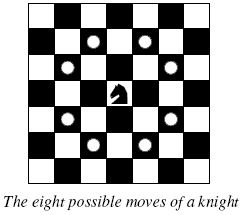A Knight's Journey
Description  Background
Background
The knight is getting bored of seeing the same black and white squares again and again and has decided to make a journey around the world. Whenever a knight moves, it is two squares in one direction and one square perpendicular to this. The world of a knight is the chessboard he is living on. Our knight lives on a chessboard that has a smaller area than a regular 8 * 8 board, but it is still rectangular. Can you help this adventurous knight to make travel plans? Problem Find a path such that the knight visits every square once. The knight can start and end on any square of the board. Input
The input begins with a positive integer n in the first line. The following lines contain n test cases. Each test case consists of a single line with two positive integers p and q, such that 1 <= p * q <= 26. This represents a p * q chessboard, where p describes how many different square numbers 1, . . . , p exist, q describes how many different square letters exist. These are the first q letters of the Latin alphabet: A, . . .
Output
The output for every scenario begins with a line containing "Scenario #i:", where i is the number of the scenario starting at 1. Then print a single line containing the lexicographically first path that visits all squares of the chessboard with knight moves followed by an empty line. The path should be given on a single line by concatenating the names of the visited squares. Each square name consists of a capital letter followed by a number.
If no such path exist, you should output impossible on a single line. Sample Input 3 1 1 2 3 4 3 Sample Output Scenario #1: A1 Scenario #2: impossible Scenario #3: A1B3C1A2B4C2A3B1C3A4B2C4 Source
TUD Programming Contest 2005, Darmstadt, Germany
|
=====================================题目大意=====================================
输出国际象棋中马遍历指定规格棋盘的字典序下的第一条路径(路径中每个格子由一个大写字母后跟一个数字来描述)。
=====================================算法分析=====================================
我在网上的题解和POJ的[Discuss]中发现不少人都认为题意遗漏,没有说字母代表的是列而数字代表的是行。
事实上只要仔细看题就会知道谁作为列谁作为行是无所谓的。
但在这里考虑到国际象棋棋盘的实际情况,我也就用字母代表列而数字代表行了。
算法明显是用DFS+回溯,只是由于要求输出的路径是字典序下的第一条,所以需要处理以下两点:
一、DFS起点的枚举需要首先尽量使列(也就是字母)小,其次尽量使行(也就是数字)小。
二、DFS的方向数组需要首先尽量降低列(也就是字母)的大小,其次尽量降低行(也就是数字)的大小。
关于第二点有个神问题:只考虑以左上角(也就是第1行第A列)为起点的路径也能AC。
我在网上的一些题解中也发现了这样的做法,但是它们都没有给出这么做的理论依据。
考虑到本题的本质是哈密顿通路(注意是通路不是回路),我稍微看了点此方面的资料,也没有发现支持这么做的定理。
只有留着以后再仔细斟酌了。下面顺便附上探究该问题用的测试代码。
=======================================代码=======================================
一、AC代码。
#include<stdio.h>
#define LEGCORD(COL,ROW) ((0<=COL&&COL<Q)&&(0<=ROW&&ROW<P))
const int Dir[8][2]={{-2,-1},{-2,1},{-1,-2},{-1,2},{1,-2},{1,2},{2,-1},{2,1}};
int T,P,Q,PathLen,SavePath[30][2];
bool HashSquare[30][30],GetAns;
void DFS(int Col,int Row)
{
SavePath[PathLen][0]=Col;
SavePath[PathLen][1]=Row;
++PathLen;
HashSquare[Row][Col]=true;
if(PathLen==P*Q)
{
GetAns=true;
for(int i=0;i<PathLen;++i)
{
printf("%c%d",SavePath[i][0]+'A',SavePath[i][1]+1);
}
printf("\n");
}
else
{
for(int n=0;n<8;++n)
{
int tmpcol=Col+Dir[n][0];
int tmprow=Row+Dir[n][1];
if(LEGCORD(tmpcol,tmprow)&&!HashSquare[tmprow][tmpcol])
{
DFS(tmpcol,tmprow);
if(GetAns) { break; }
}
}
}
--PathLen;
HashSquare[Row][Col]=false;
}
int main()
{
while(scanf("%d",&T)==1)
{
for(int cas=1;cas<=T;++cas)
{
scanf("%d%d",&P,&Q);
GetAns=0;
printf("Scenario #%d:\n",cas);
/*正常应该是这么做↓
for(int col=0;col<Q&&!GetAns;++col)
{
for(int row=0;row<P&&!GetAns;++row)
{
DFS(col,row);
}
}
但这么做也能通过↓*/
DFS(0,0);
if(!GetAns) { printf("impossible\n"); }
if(cas+1<=T) { printf("\n"); }
}
}
return 0;
}
#include<stdio.h>
#define LEGCORD(COL,ROW) ((0<=COL&&COL<Q)&&(0<=ROW&&ROW<P))
const int Dir[8][2]={{-2,-1},{-2,1},{-1,-2},{-1,2},{1,-2},{1,2},{2,-1},{2,1}};
int T,P,Q,PathLen,SavePath[30][2];
bool HashSquare[30][30],GetAns;
void DFS(int Col,int Row)
{
SavePath[PathLen][0]=Col;
SavePath[PathLen][1]=Row;
++PathLen;
HashSquare[Row][Col]=true;
if(PathLen==P*Q)
{
GetAns=true;
for(int i=0;i<PathLen;++i)
{
printf("%c%d",SavePath[i][0]+'A',SavePath[i][1]+1);
if(i+1<PathLen) { printf(" "); }
}
printf("\n");
}
else
{
for(int n=0;n<8;++n)
{
int tmpcol=Col+Dir[n][0];
int tmprow=Row+Dir[n][1];
if(LEGCORD(tmpcol,tmprow)&&!HashSquare[tmprow][tmpcol])
{
DFS(tmpcol,tmprow);
if(GetAns) { break; }
}
}
}
--PathLen;
HashSquare[Row][Col]=false;
}
int main()
{
while(scanf("%d%d",&P,&Q)==2)
{
printf("------------------[ %d X %d 棋盘测试 ]------------------\n\n",P,Q);
for(int col=0;col<Q;++col)
{
for(int row=0;row<P;++row)
{
printf("( %c , %d ) : ",col+'A',row+1);
GetAns=0;
DFS(col,row);
if(!GetAns) { printf("impossible\n"); }
}
}
printf("\n--------------------------------------------------------\n\n");
}
return 0;
}







 本文深入探讨了AI音视频处理领域中的关键技术——视频分割与语义识别,通过详细解释这些技术的工作原理、应用场景及实际应用案例,旨在帮助读者理解并掌握如何利用AI技术对音视频进行高效处理与分析。
本文深入探讨了AI音视频处理领域中的关键技术——视频分割与语义识别,通过详细解释这些技术的工作原理、应用场景及实际应用案例,旨在帮助读者理解并掌握如何利用AI技术对音视频进行高效处理与分析。

















 被折叠的 条评论
为什么被折叠?
被折叠的 条评论
为什么被折叠?








